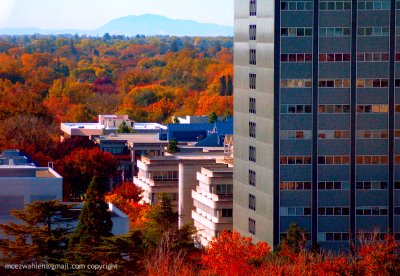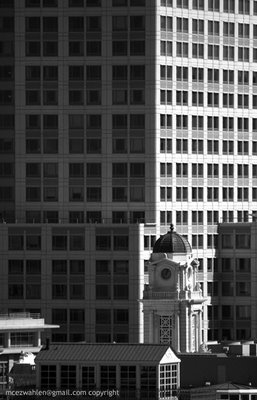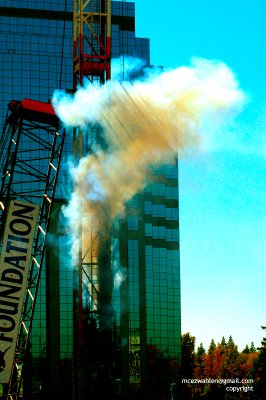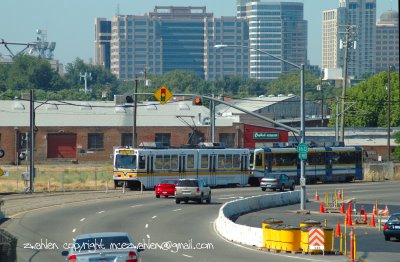Thursday, November 30, 2006
News and Review: None dare call it sprawl
My wife and I lived in Natomas for 2 1/2 years after we were married before moving downtown. Right away we knew it wasn't something we were going to enjoy. We tried hard as to make it that walkable community by walking to Kings games, walk to Bella Bru or Blockbuster. I've always thought if other people saw us walking places, they would follow suit and give it a shot...but it just didn't last for long. Others never came and it was quite a boring walk that was more of a hassle than enjoyful. Yes, walking to games sounds a little a bit much (it was only about 20 mins though), the first time or two was okay, but after that no thanks.
Now a days, I rarely ever get in my car after making the drive back home from work in the Roseville area. God, I wish light rail ran out to Roseville. Anytime we go out to dinner or drinks, or to see a show we walk. We really settled into the perfect area in the middle of everything which makes it easy.
There were a few items in the article I found interesting and odd:
- “For its time, it was ahead of its time,” Mende said. “It was the smart-growth model, part one.”
It may have been in the plans, but I fail to see how anything that was built in Natomas was ahead of its time.
- North Natomas was one of the first developments to cluster new houses around parks and school sites; nearly 80 percent of North Natomas homes were planned within walking distance of open space.
First of all, open space my mind is critical in creating neighborhood gathering points. As I walk and drive around Sacramento I see some great opens spaces that are used by the public the way it should be. Other times, I come across open space and that's all it really is "open space" with no connection to the neighborhood or community.
Open space should be inviting and have a functional use within the enviroment in which is it placed. Open space in Natomas is open space for the sake of open space.
Even if they did do that right, okay great, but what about the many other items that truly make a walkable community? Food? Shopping? Entertainment? Not having the Natomas light rail line up and running by now doesn't help.
I found it so funny how they even mention that the retail in Natomas isn't walkable. You go to one store in the new "Sacramento Gateway", you get in your car to go to the next..argggg!!
Natomas became a place where you open your garage to leave your house, you open your garage to come back open, only to close it once you pull in. Which I was just as guilty of as everyone else. There is no neighborhood feel in Natomas. There is no connection of anything in the area.
Who do you blame in this case? I was a little young when all the planning began for Natomas, but it sounds like the plan was there to create the right enviroment. So where did it go wrong? My guess is the city messed it up by allowing developers to create what we see there now. Allowing too much rezoning instead of letting it run its course.
The Delta Shores sound interesting, but my guess is it will become another Natomas with maybe a few mixed use, smart growth areas thrown in.
As the article mentions, while the central city is filling in the gaps and creating that walkable community, but the railyard are most likey our last chance to start something from scratch. Let's not mess it up.
____________________________________________________________________
None dare call it sprawl
But just because you call it ‘smart growth’ doesn’t mean it is
Sacramento's favorite daughter, author Joan Didion, once told SN&R that she couldn’t bear to come home to Sacramento and look around the great sprawling developments in Natomas; those concrete-covered acres used to be the most beautiful green spaces in the region.
Just drive up Truxel Road to see what she means. At one intersection, seven lanes of smelly, smog-inducing traffic come to a stop on their way north. Pedestrians wait endlessly at the corners in order to dash from one shopaholic’s paradise to another. They look as edgy as greyhounds waiting for the light to change.
Sacramento's favorite daughter, author Joan Didion, once told SN&R that she couldn’t bear to come home to Sacramento and look around the great sprawling developments in Natomas; those concrete-covered acres used to be the most beautiful green spaces in the region.
Just drive up Truxel Road to see what she means. At one intersection, seven lanes of smelly, smog-inducing traffic come to a stop on their way north. Pedestrians wait endlessly at the corners in order to dash from one shopaholic’s paradise to another. They look as edgy as greyhounds waiting for the light to change
For its time, it was ahead of its time,” Mende said. “It was the smart-growth model, part one.” In the ’80s and ’90s, developers and city staff weren’t plopping smart-condo and retail projects in the middle of the central city, or replenishing the city’s residency-hotel stock in order to preserve diversity, or building 50-story condo towers--which went from new thing to old news in the time it took to get the permits.
North Natomas was one of the first developments to cluster new houses around parks and school sites; nearly 80 percent of North Natomas homes were planned within walking distance of open space. Within housing tracts, “snout houses,” with their garages thrust forward, were banned, and porches and balconies were added to bring people outdoors. To “create a sense of place,” North Natomas got its own town center, with a satellite community college and a new high school.
The town center also was supposed to have a public community center and a large library, but those have yet to break ground. The community currently shares one tiny library site with high-school students; it even sits on the Inderkum High School campus.
Though residents snapped up the homes far quicker than the city anticipated, the planned employment districts that were supposed to minimize commute hours still could take decades to mature. Without their developers’ fees, there’s no money for community centers. In the meantime, developers are pushing through rezones that turn prospective employment-center land and open space into even more housing and shopping. The small neighborhood-serving businesses that create the diversity found in vibrant areas like Midtown never materialized, neither did some of the small school sites anticipated by residents, but there’s plenty of big-box shopping.
The transition from community plan to sprawling community irritates the hell out of residents like Barbara Graichen, president of the Natomas Community Association.
“In East Natomas, a golf course was proposed. That was the first project that was pulled out,” she said. Bike lanes are inconsistent and stop short at numerous barriers. No one is safe walking through the sprawling shopping centers, and neither are the students who walk to middle schools on streets with no sidewalks and gutters. Though the plan was to get people closer to their jobs and off the roads, Interstates 80 and 5 are at a standstill during commute hours. North Natomas’ “Town Center” was supposed to bring people together, but it’s mainly a big shopping center, one that Graichen equates with “Anywhere, USA.” With no place to walk to within their neighborhoods, residents end up driving to shopping centers for entertainment.
Whatever the developer wants to build, Graichen said, they call “smart growth.”
“Developers aren’t evil,” Mende said. “They’re just responding to their perception of the market.”
Traditionally, say city planners, local governments ask developers to innovate--to push good, sustainable, environmentally responsible design forward--but developers are building what they know how to build and waiting to see how their peers and competitors handle the same challenges. Progress happens incrementally, especially in large undeveloped areas. Suburban developers look for economies of scale and tend to cluster similar uses together, inspiring phrases like “cookie-cutter development.”
Traditionally, say city planners, local governments ask developers to innovate--to push good, sustainable, environmentally responsible design forward--but developers are building what they know how to build and waiting to see how their peers and competitors handle the same challenges. Progress happens incrementally, especially in large undeveloped areas. Suburban developers look for economies of scale and tend to cluster similar uses together, inspiring phrases like “cookie-cutter development.”
But without that kind of diversity, North Natomas resembles nothing more than sprawling neighborhoods facing as many malls as can fit on the landscape. And even the malls aren’t walkable.
“You have to drive your car from one side of the shopping center to the other,” said Graichen. “They couldn’t be less pedestrian friendly.”
“The elected officials have all these wonderful policies,” she said. “They just don’t implement them.”
Though North Natomas is expected to mature and attract more employers, churches, parks and civic uses eventually, smart-growth advocates wonder whether future developments will fail to meet the city’s smart-growth ideals, too.
Delta Shores, 926 acres at the southern border of the city adjacent to Interstate 5, is one of the largest undeveloped tracts of land in Sacramento. Developers who are proposing a “master-planned community” say they’re committed to smart-growth design. If you’re wondering, they say they won’t allow acres and acres of stucco in varying shades of tan and gray. “We hate that,” said Tom Karvonen, SunCal Companies’ project manager for Delta Shores. “We’ve got blues and greens and reds.”
The developer’s early November application to the city described Delta Shores as “a compact residential community of approximately 4,600 new homes oriented in a modified traditional grid pattern and anchored by two mixed-use retail centers--a regional oriented Town Center and Neighborhood Village Center.” Mende said the village will be right in the middle of the project and will provide neighborhood-serving retail.
Like parts of North Natomas, Delta Shores originally had been zoned for employment--high-tech offices, generally. But employers never materialized. As in North Natomas, the developers want to rezone light industrial land for housing and retail--the “regional” retail along Interstate 5 probably means big boxes and more cars.
Mixed use, as an ideal, means that houses, jobs, entertainment and shopping are clustered together so people can walk, bike and ride mass transit. Like North Natomas, the Delta Shores development bases its transportation plan on the future expansion of light rail.
Delta Shores is a huge opportunity and a tract of land that’s been skipped over for years, said Mende. “It’s closer to the central city than Elk Grove, which can reduce vehicle-miles traveled.”
But unlike North Natomas, said Karvonen, Delta Shores will include enough senior housing, smaller village-style retail, and 40 acres of wetlands. Fifteen percent of residences will be affordable (apartments only) and the development will include a 1.5-mile long walkable, bikeable linear parkway. “This is going to be 800 acres as opposed to 9,000,” he said, “so we can cluster open spaces together.”
Because the development is small enough, developers also can make it very permeable. They won’t have to wall it in, which means bikers and walkers can move freely.
Altogether, Mende sees this as evidence that developers are moving toward smarter growth. “There are fewer cul-de-sacs, fewer gated communities occurring,” he said. Developers also have seen that customers will pay a little extra to have walkable, bikeable trails, so those trails are incorporated into plans.
But there’s still very little of the mixed-use development that’s begun to fill in the holes in the central-city landscape. Attractive, walkable centers with shops on the ground floors and condos or apartments above? That’s something that doesn’t make it into suburban communities, Mende said. “We try to push as much as we think the market will bend. ... To hold Delta Shores to the fine-grained diversity in a downtown project isn’t going to work.”
If the city insists on uses that don’t pencil out, projects may not get built at all.
Developers may not be ready to create the mixed-use spaces planners like to see, but the city is running out of open space and opportunities to get it right. One of the last opportunities might be the rail yards, and if Sacramentans want a particular kind of development, they’ll have to attend city-council meetings and planning-commission meetings to demand it.
North Natomas had a smart-growth community plan that was supported by residents, and look at it now.
Towers in Trouble?
If the project is already $70M over budget, that number is for sure going to go up. While lagging sales don't help, the projects biggest problem seems to be the rising costs. Higher costs are always built into estimates, but it sounds like they went much higher than he was expecting.
I still think if he can get this built, he will sell out over the next couple of years, the problem is like the article says he probably isn't going to make much money in the end. He might even just be looking to break even right now.
CalPERS will get their share for their backing, Deutsche Bank will get its money, and Saca will be the last person to make a profit off of this project, if there is anything left.
He's overcome a lot of hurdles to this point, so my guess is he will over come this one as well. Having Bovis Lend Lease on board at this point is definitely a plus. The next couple months will tell an awful lot.
____________________________________________________________________
Towers project facing hurdles
Downtown high-rise residence far over budget; unit sales lag.
It's little more than a giant hole in the ground, but already the 53-story Towers hotel and condominium project is $70 million over its original $500 million budget.
Meanwhile, sales of the Towers' condos are slow, and developer John Saca has switched general contractors.
What all of that means for one of the tallest residential construction projects on the West Coast remains to be seen. Saca is in talks with his backers for more money, and his isn't the first commercial development to overshoot its budget. Contractor changes aren't as common, but Saca says that the swap brings in a more experienced high-rise mixed-use construction firm.
However, one thing is clear: Saca admits the Towers, at Third Street and Capitol Mall, is being pinched between a weak housing market and rising prices for materials such as steel and concrete.
Despite those challenges, Saca, a scrappy local developer who has already brought his project farther along than naysayers thought he would, remains optimistic.
"We're close to a deal with our backers for more money," he said Wednesday. "We're pumping along."
Saca went public two years ago with his vision for a massive twin-tower structure anchored by a luxury hotel, high-end retail and 804 condos rising 600 feet and drastically changing the Sacramento skyline. He figured it would cost about $500 million for the land and construction.
Many thought the building was too ambitious to be Sacramento's first high-rise condo project and questioned whether there were enough customers to fill all those units, priced from $368,000 to $852,000.
Saca, whose father founded the Filco home appliance chain, had a reputation as a savvy land investor and shopping center developer, but had no history with high-rise construction. Still, he gained credibility in April when the giant California Public Employees' Retirement System agreed to invest $100 million in his project.
Two months later, he signed a $375 million loan agreement with Deutsche Bank, contingent on Saca preselling 400 condos. Saca committed his own money to make up the balance.
Construction started, but as massive pile drivers over the summer banged away at the Towers' downtown Sacramento site, Saca realized the initial cost estimates fell short.
He appealed to Sacramento city officials and received an $11 million subsidy in October for the 18-story Intercontinental Hotel that will anchor one of the building's two towers. Now, he's in talks with his other financial backers for more.
"Costs are higher than when we struck our deals," Saca said. "We've had to go back, and we're close to loan closings with CalPERS and Deutsche Bank."
A CalPERS spokesman on Thursday said that the system's real estate representatives "have been in discussions with Saca about more money," but, like Saca, declined to say how much.
Calls to Deutsche Bank's New York offices were not returned.
Sacramento developer Paul Petrovich said that Saca probably will give up more or all of his ownership stake in the project for more construction cash.
"The pot at the end of the rainbow for John at this point isn't money, it's credibility with politicians, other cities and other lenders," Petrovich said.
With the Towers on his resumé, Saca could get into even bigger projects down the road, Petrovich said.
Besides funding challenges, Saca also said the condo market has gone soft with the rest of the housing market, and the Tower's sales are "slowing down." He also has a condo competitor, Craig Nassi, whose Denver-based BCN Development has plans to build the Aura tower two blocks east on Capitol Mall and Sixth Street.
Through September, buyers had made deposits on 364 units at the Towers, according to the most recent figures from Hanley Wood Market Intelligence, a Costa Mesa firm that tracks residential construction.
The slump didn't deter Bovis Lend Lease Inc. from taking over the general contracting duties from Turner Construction Co., which had overseen the project's pile driving phase. Both firms are based in New York City.
Privately-held Bovis is one of the world's largest project management and construction companies.
Bovis' Western Regional Vice President Todd Pennington said that he couldn't yet estimate when the Towers will open.
"We're developing schedules and hiring the trade contractors," Pennington said. "We'll just keep moving from where others left off and keep the progress going."
Wednesday, November 29, 2006
Tower Crane Rises on Capitol Mall
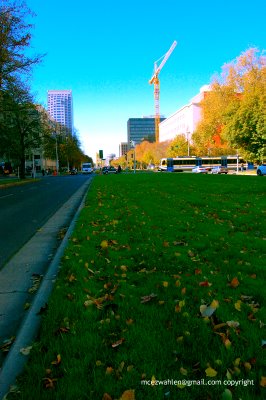

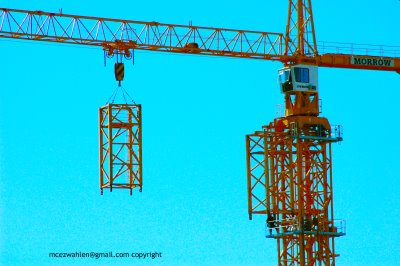

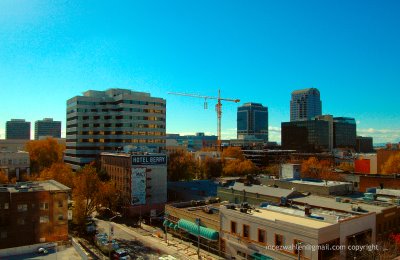
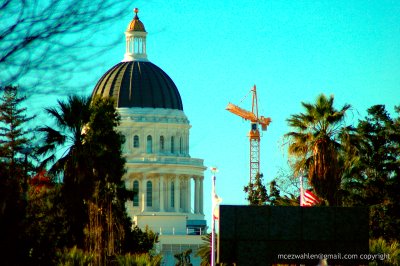
Menacing the Capitol Dome.
Tuesday, November 28, 2006
New Tallest?


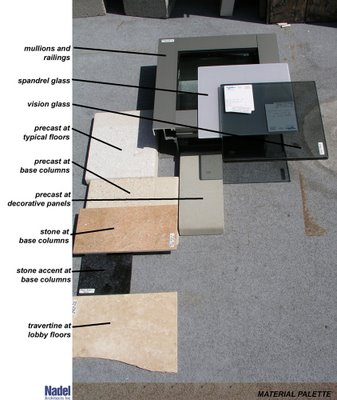
The Capitol Grand Tower, which is proposed for J and 12th Streets has now gone through four re-designs. I really like the way this new design looks... a hint of class. It appears to be 65 stories tall, so the height for this might be in the 750' range… 135' taller than the under construction Towers on Capitol Mall. When they start knocking down the current building sitting at 12 & J then I'll know it's true :)
Monday, November 27, 2006
More Renderings of the Crystal Ice Project
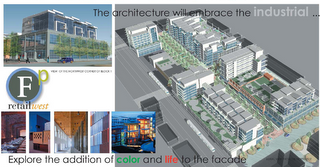

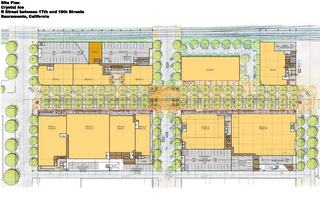
In addition, the R Street Market Plaza will go down the middle of R Street starting at 16th and ending at the new Safeway to create a pedestrian plaza. That portion of the project is also in design right now.
The project total size is 186 housing units, 29K office, and 110K retail.
The project looks very cool in the rendering, but my concern is that like the East End Gateway where they shot for an extremely high quality of architecture, which this appears to be as well, the project wound up being axed due to being too expensive to build. I sure hope this project doesn't fall into the same bucket.
I have to imagine after having it happen to him once, Friedman has done some extra homework to ensure it doesn't.
This project has always ranked as one the projects out there that would have the biggest impact for the area, along with the JDV, The Towers, Cathedral Square, the canceled East End Gateway, and anything with the letter "K" in it. (The Greyhound would be in this bucket as well, but I think it's pretty clear that is staying for a while)
The retail space is being marketed by Retail West (click for marketing material and more renderings) out of San Francisco. So far the only tenants I know of is a La Bou Bakery in the old Orchard Supply that owner of La Bou, Trong Nguyen, owns and is part of the overall project.
If the project does go forward, one corner of the project that most likely won't be included at first is the one closest to 16th and Q. That parcel is owned by the Benvenutti family who at last report was not partaking in the overall project, even though the plans were down for all four corners. That could have changed in the past few months though.
Driving down 16th Street last week, I noticed there are signs "just what midtown has been waiting for" along 16th Street, with renderings of the project on the buildings themselves down 16th Street. I think he has been working on plans for about a year now, so he could be getting close.
From the renderings, the buildings themselves don't really seem to keep with the gritty industrial feel of R Street, but it could be just that the renderings are all glossed up and shiny looking for marketing purposes.
The potential finished project could though still maybe keep some industrial grit feel, which for this area might now be left only to include the street itself keeping the cobblestone and rail tracks once the Plaza is complete. Originally, the main existing Crystal building was to be kept, so it will be interesting to see how that works into the plans and renderings we see here, if it is still part of the plans.
We all know new developments can't really replicate the charactor of older building so keeping the buildings along R Street with the same character at Fox and Goose and "The Building" at 10th and R would be ideal. There are many other down R Street as well...minus the Buzz Boxes.
At first I thought keeping the CADA Warehouse in tack was a mistake given the extra cost and time of preserving, but I'm glad it went that route. I've come to really like that building and what it will do for the charactor of R Street.
GBD out of Portland are the architects on the project.
Tuesday, November 21, 2006
Bridging I-5

Three of the original concepts... I think these are the best to choose from so far.

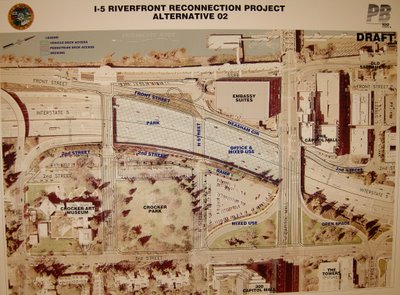
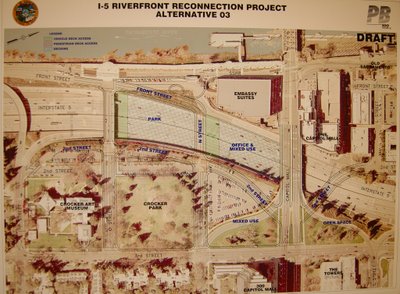
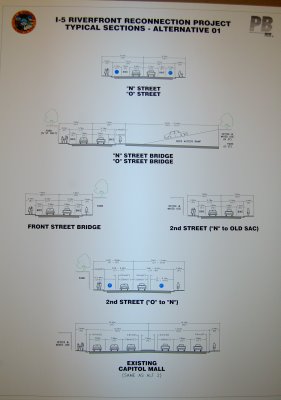
New Concepts
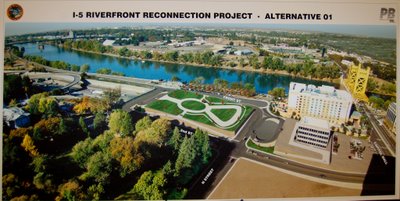

These are two new concepts and I think they are awful. The park area is raised up and doe's not invite people into the area from Crocker Park at all. Put a parking lot on top of the freeway... one hell of a way to use newly create public space!!! That office area is about as boring as they come.
These renderings are concepts that were selected and modified from the original 12 concepts that were presented in 2004. The original plan was to deck the freeway from Capitol Mall to R Street, the plan was then reduced down to two block stretch because significant constraints emerged with the three block full-decking concepts.
The project would be funded by Federal TransportationAppropriations, Federal Highway Administration National Corridor Planning and Development Program totaling about $5 million. About $1 million comes from local funding, $300,000 From Caltrans community-planning grant. The full cost to build this project range from $50 million to $500 million depending on which design is selected by the City Council and city committees.
Future financing for design and construction is likely to come from a varity of public and private funding sources.
Anticipated Milestones
Fall 2006
Present Alternatives to Community (Project Study Report)
January 2007
Present to City Council
December 2007
Complete Project Study Report
Mid-2010
Complete Project Report/Environmental Document
The current planning and environmental phase is anticipatedto be complete by 2011.
Friday, November 17, 2006
LJ Urban in the SBJ
There is a very good piece in the Journal about LJ Urban and what they are doing in West Sacramento and their approach to development. When you google the phrase "eco-urban", they come up number 2 in the results. If we google bomb maybe we can get them #1!!
They look to be a key in the development of West Sac as they control 7 sites in the area, including the B Street West Project just approved by the city.
Please check out their blog to help with ideas regarding future development that the company will be under taking as well as other good conversation on urban topics.
I know some of the team comment here (tell Mary cute kid), so this isn't a butt kissing comment, but I am envious of a group of people this young being able to find something they love to do ast such a young age, have found a way to make a career out of it while helping Sacramento achieve it's goals.
I can't complain about my job at all since it provides very well for my family, but I would have to loved to have found something I love doing at a younger age. Given what I have read and seen so far, I think we can look forward to great things from this group of people.
Last Piece of 700 Block on K Street Complete
Also very good news is that while they would not comment on retailers until the leases are signed, they said it would be a mix of national and local business.
Everyone wants to see local business represented in this project, but with nationals in the mix attracting a larger range of people, I think there is a better chance of more smaller retail thriving on K Street. Target date for opening of retailers in still Oct of next year. It they are open by mid-Nov, I'll be happy.
It also mentions more details will be available next month for city council on the 800 block in which Saca, Mo Mohanna and John Lambeth are planning offices, condos and retail. Originally, there were two options for that block. Two towers of 600 condos/lofts, or one tower of 300 condos/lofts, and one tower of office space.
Given the slowing housing market, high constructions costs, and the surge in office leasing, I would think they will be looking more closely at the office and condo mix. Who knows though, the market might change again in the next few years that I assume this project could be completed. Being able to see into the future sure would help in these situation...ha
Having office space now, under construction or looking to breakgound at anytime that will be completed over the next couple of years looks good for you, who knows after that though.
